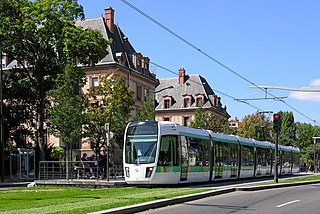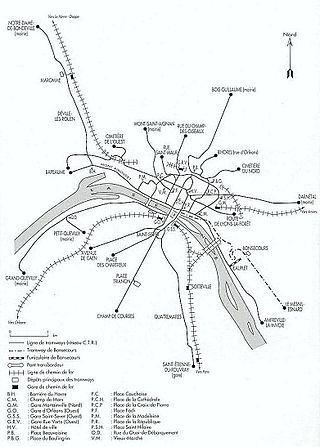
Balard is the southwestern terminus of Line 8 of the Paris Métro in the 15th arrondissement of Paris. Since 16 December 2006, it has also been a stop on tramway T3a as part of the initial section of the line between Pont du Garigliano and Porte d'Ivry. The station is named after Place Balard, itself named after Antoine-Jérôme Balard (1802-1876), a French chemist and the discoverer of bromine. Among the stations serving the Boulevards des Maréchaux along the former gates of Paris, it is the only one not called Porte de…, though it serves the Porte de Sèvres.

Pont de Sèvres station is a station of the Paris Métro on Line 9, serving as its western terminus. It is located near the Pont de Sèvres, which is a bridge on the Seine connecting to Sèvres.

Porte de Versailles is a station on line 12 of the Paris Métro, a stop on tramway T3a as well as the southern terminus of tramway T2 in the 15th arrondissement. It is named after the Porte de Versailles, a gate in the 19th century Thiers wall of Paris, which led to the city of Versailles.

The Arrondissement of Rouen is an arrondissement of France in the Seine-Maritime department in the Normandy region. It has 216 communes. Its population is 639,363 (2021), and its area is 1,936.2 km2 (747.6 sq mi).

The Île-de-France tramways is a network of modern tram lines in the Île-de-France region of France. Fourteen lines are currently operational, with extensions and additional lines in both construction and planning stages. Although the system mainly runs in the suburban regions of Paris, lines T3a and T3b run entirely within Paris city limits, while lines T2 and T9 start their routes within Paris' borders. While lines operate independently of each other and are generally unconnected, some connections do exist: between lines T2 and T3a, T3a and T3b, T1 and T5, T1 and T8, T8 and T11 Express, T3a and T9 and T6 and T10. However, the final design of the entire planned tram network is fairly integrated.

Le Havre tramway is a modern two-line tram system in the city of Le Havre in Normandy, France. The modern tramway opened on 12 December 2012.

Trams in Nice was the first-generation tramway system serving the city of Nice, France, which operated from 27 February 1879 to 10 January 1953.

The Nantes tramway is a tramway system operating in the city of Nantes in Pays de la Loire, France. The first tramway in Nantes opened in 1879 and closed in 1958 due to bombing damage during World War II, while the present tramway was re-introduced to the city in 1985.

The Tramway Français Standard (TFS) is a type of tram designed and manufactured by Alstom for use on various tramway systems in France. The TFS is no longer in production, having been superseded by the Alstom Citadis range of tramcars.

The Marseille tramway is a tramway system in Marseille, France. The city's modern tram network now consists of three lines, serving 32 stations and operating over 15.8 kilometres (9.8 mi) of route. The current, modern Marseille tram network opened on 7 July 2007.

The Agglomeration community of Rouen is a former intercommunality located in the Seine-Maritime département in the Normandy region of northern France. It was created in January 2000. With three other intercommunalities it formed the Agglomeration community of Rouen-Elbeuf-Austreberthe in 2010, which was replaced by the Métropole Rouen Normandie in 2015.

The Saint-Étienne tramway is a tram system in the city of Saint-Étienne in the Rhône-Alpes (France) that has functioned continuously since its opening in 1881. The first tramway line was steam-operated and was opened by the Chemins de Fer à Voie étroite de Saint-Étienne (CFVE) on 4 December 1881, stretching for 5.5 km between La Terrasse and Bellevue. The CFVE took over the Compagnie des Tramways Électriques de Saint-Étienne lines and discontinued the use of steam in 1912.

Île-de-France tramway Line 2 is part of the modern tram network of the Île-de-France region of France. It connects the commune of Bezons in the north to the Porte de Versailles Métro station in Paris in the south, serving Hauts-de-Seine and its La Défense business district.
The Transports en Commun de l'Agglomération Rouennaise (TCAR) is the Rouen public transport agency. TCAR is a subsidiary of Veolia Transport and covers 45 communes of the CREA.

Métropole Rouen Normandie is the métropole, an intercommunal structure, centred on the city of Rouen. It is located in the Seine-Maritime department, in the Normandy region, north-western France. It was created in January 2015, replacing the previous Communauté d'agglomération Rouen-Elbeuf-Austreberthe. Its area is 663.8 km2. Its population was 492,681 in 2014, of which 111,360 in Rouen proper.
The city of Rouen has a number of different modes of transportation available for use.

There have been two separate generations of trams in Rouen. The first generation tramway was a tram network built in Rouen, Normandy, northern France, that started service in 1877, and finally closed in 1953. There were no trams at all in Rouen between 1953 and 1994, when the modern Rouen tramway opened.

Transports publics de la région lausannoise, often abbreviated simply to tl, are the main operator of public transport in Lausanne and the wider agglomeration. As of 2012, TL operates a network of 10 trolleybus routes, 25 conventional bus routes and two métro lines, using more than 290 vehicles. TL operates weekend night services and demand responsive transport.

The Besançon Tram network dated back to a horse tram service inaugurated in 1887. The first two electric tram lines began operating in 1897, joined later by more. However, the system, which used only single tracks for its two lines, was badly damaged during World War II from which its finances also emerged in a parlous condition. In 1952, the operation having run out of funding possibilities, the Besançon trams were withdrawn: a city bus service was inaugurated in December 1952.
The Elbeuf tramway was put into service in 1898 in the southern part of the Seine-Inférieure department to facilitate the movement of the residents of the textile city of Elbeuf and its working-class suburbs. With its four standard gauge lines, each nine kilometers long and diverging from Place du Calvaire, the network transported up to 1.5 million people, in 1899, at the beginning of the operation.




















